The Orogenic Crixás Gold Deposit, Goiás, Brazil: A Review and New Constraints on the Structural Control of Ore Bodies
Abstract
1. Introduction

| [12] Kuyumjian & Araujo Filho, 1984 | [13] Thompson, 1991 | [2,3] Jost et al., 2010 & 2019 | [4] Ferreira et al., 2021 | This Work | |
|---|---|---|---|---|---|
| Braziliano (Neoproterozoic) | D5 Upright folding, F5ax: N-S to N30W | D4 Crenulation of the thrust-related foliation | D4 E-W compression, Crenulation | D4 E-W compression, Crenulation | |
| D3 Top-to-the-E thrusting, Mineralization | D3 S-thrusting of Mara Rosa magmatic arc, Rio Vermelho Antiform, Recumbent F3 plunging WNW, Gold remobilization | Stage 3 S-thrusting of Mara Rosa magmatic arc, Partial resetting of detrital zircons in Córrego Geral Formation | D3 S-thrusting of Mara Rosa magmatic arc, S3 schistosity in the hangingwall of the Rio de Bois thrust | ||
| Paleoproterozoic (Rhyacian) | D2 Tilting of S1 and V1, Recumbent folding F2, L2 stretching, Free-milling gold mineralization | ||||
| D2 Semi-recumbent folds F2, Thin-skinned thrusting, Overturn of the stratigraphy, Gold mineralization | Stage 2 Folding, NE-verging thrust, Gold mineralization, Local high-strain mylonitization | D1 Sagduction and regional synclinorium, Isoclinal upright folding F1, V1 quartz veins, Massive and disseminated sulfides and gold mineralization | |||
| D1 Tight to isoclinal folds F1, S1 parallel to S0, metamorphic fabric | |||||
| D0P, Stage 1—Rifting Restricted euxinic basin and clastic input from Rhyacian arc, Nonconformity | |||||
| Archean | D4 Upright folding, Rio Vermelho anticline | D1-2 Isoclinal folding, Archean nappes, Inverted stratigraphy | Sagduction | ||
| D3 Recumbent folds, 2nd refolding W plunging | |||||
| D2 Sagduction, 1st refolding | |||||
| D1 Semi-recumbent folds, synclinorium | |||||
| D0A Archean ultramafic and mafic rocks | |||||
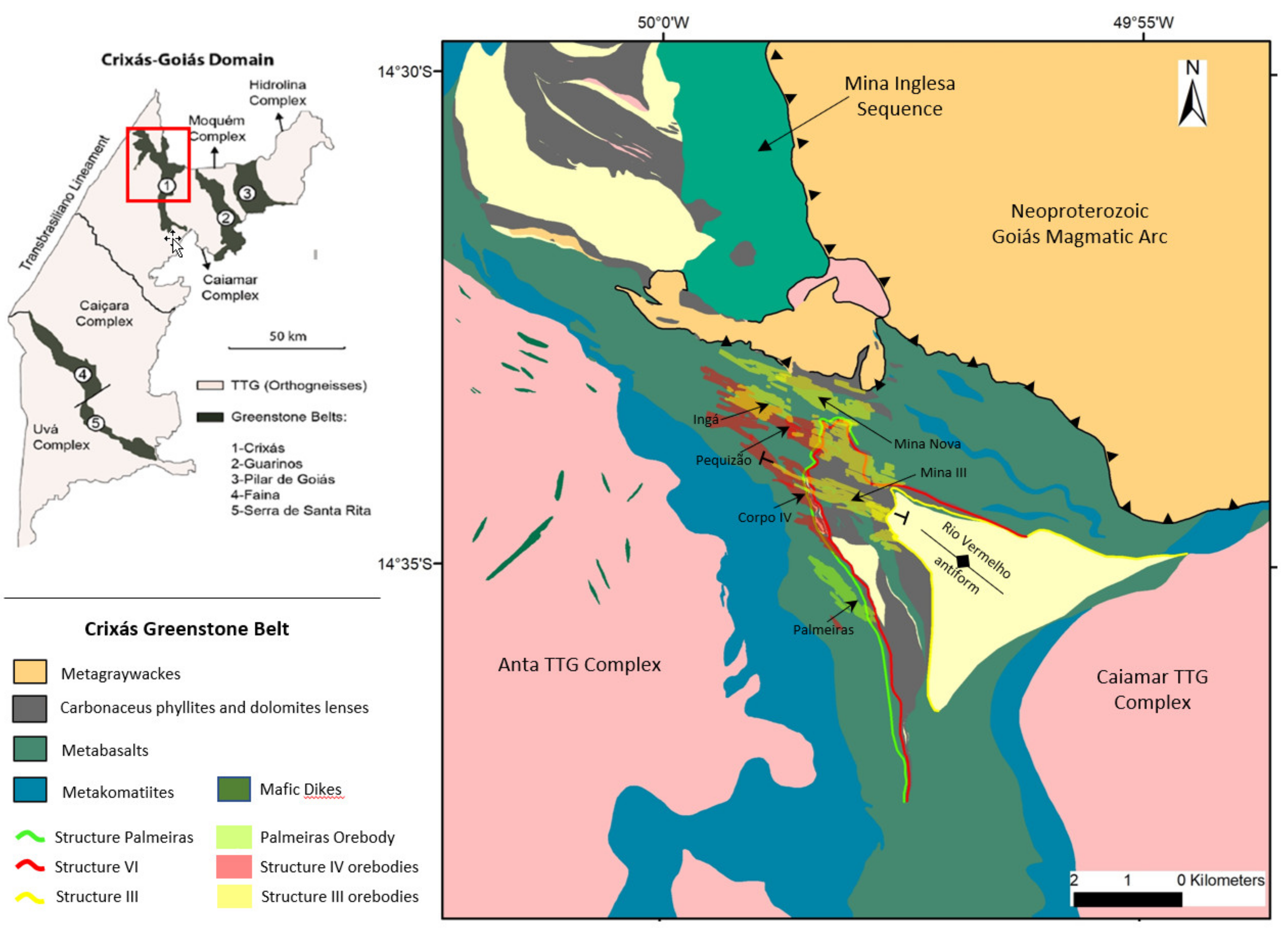
2. Regional Geological Setting: Crixás Greenstone Belt
3. Crixás Gold Camp—History of Exploration, Mining and Scientific Research
4. Lithostratigraphic Setting and Metamorphism of the Crixás Greenstone Belt
5. Structural Setting
5.1. Existing Structural Schemes and Models
5.2. New Structural Data
5.3. Ore Body Geometry
5.4. Structural Control on Mineralization
6. Hydrothermal Alteration and Gold Mineralization
7. Relative and Absolute Timing (Geochronology) of Host Rocks and Gold Mineralization
8. Hydrothermal Fluids
9. Discussion
9.1. Origin of High-Grade Oreshoots
9.2. Critical Assessment of the Current Structural Framework
9.3. A New Structural Scheme
10. Conclusions
Author Contributions
Funding
Acknowledgments
Conflicts of Interest
References
- Thomson, M.L.; Fyfe, W.S. The Crixás gold deposit, Brazil; thrust-related, postpeak metamorphic gold mineralization of possible Brasiliano Cycle age. Econ. Geol. 1990, 85, 928–942. [Google Scholar] [CrossRef]
- Jost, H.; Chemale Jr, F.; Dussin, I.A.; Tassinari, C.C.G.; Martins, R. AU–Pb zircon Paleoproterozoic age for the metasedimentary host rocks and gold mineralization of the Crixás greenstone belt, Goiás, Central Brazil. Ore Geol. Rev. 2010, 37, 127–139. [Google Scholar] [CrossRef]
- Jost, H.; Apollo, J.F.H.; Weber, W.; Salles, R.d.R.; Marques, J.C.; Massucatto, A.J.; Costa, D.A.; dos Santos, B.A. Stratigraphic update, paleotectonic, paleogeographic, and depositional environments of the Crixás Greenstone Belt, Central Brazil. J. South. Am. Earth Sci. 2019, 96, 102329. [Google Scholar] [CrossRef]
- Ferreira, B.F.; Marques, J.C.; Frantz, J.C.; Souza, R.G.d.; Campos, M.P.; Figueiredo, F.L.A.d.R.; Padilha, N.L. Stratigraphy and U–Pb detrital zircon provenance, Crixás Greenstone Belt, Goiás-Brasil: Gold-bearing vs barren siliciclastic rocks. J. South. Am. Earth Sci. 2021, 105, 102994. [Google Scholar] [CrossRef]
- Magalhães, L. Cinturão de Cisalhamento de Empurrão Córrego Geral/Meia Pataca: Geologia, Deformação, Alteração Hidrotermal e Mineralizações Auríferas Associadas (Crixás, Goiás). Master’s Thesis, Universidade de Brasília, Brasília, Brazil, 1991. [Google Scholar]
- Queiroz, C. Evolução Tectono-Estrutural dos Terrenos Granito-Greenstone Belt de Crixás, Brasil Central. Ph.D. Thesis, Universidade de Brasília, Brasília, Brazil, 2000. [Google Scholar]
- Thomson, M.L. The Crixás Gold Deposit, Brazil: Metamorphism, Metasomatism and Gold Mineralization. Ph.D. Thesis, The University of Western Ontario, London, ON, Canada, 1987. [Google Scholar]
- Pimentel, M.M.; Fuck, R.A.; Jost, H.; Ferreira Filho, C.F.; Araújo, S.D. The basement of the Brasília fold belt and the Goiás magmatic arc. Tecton. Evol. S. Am. 2000, 31, 195–229. [Google Scholar]
- Pimentel, M.M.; Hollanda, M.H.; Armstrong, R. Shrimp U-Pb age and Sr-Nd isotopes of the Morro do Baú mafic intrusion: Implications for the evolution of the Arenópolis volcano-sedimentary sequence, Goiás Magmatic Arc. An. Acad. Bras. Ciências 2003, 75, 331–339. [Google Scholar] [CrossRef][Green Version]
- Queiroz, C.L.; Jost, H.; da Silva, L.C.; McNaughton, N.J. U–Pb SHRIMP and Sm–Nd geochronology of granite–gneiss complexes and implications for the evolution of the Central Brazil Archean Terrain. J. S. Am. Earth Sci. 2008, 26, 100–124. [Google Scholar] [CrossRef]
- Jost, H.; Junior, F.C.; Fuck, R.A.; Dussin, I.A. Uvá complex, the oldest orthogneisses of the Archean-Paleoproterozoic terrane of central Brazil. J. S. Am. Earth Sci. 2013, 47, 201–212. [Google Scholar] [CrossRef]
- Kuyumjian, R.M.; de Araújo Filho, J.O. Contrinuição à tectônica do Greenstone belt da Faixa Goiás, Crixás. Rev. Bras. Geociências 1984, 14, 92–96. [Google Scholar] [CrossRef]
- Thomson, M. Multiphase deformation and metamorphism of the Crixás greenstone belt, Goiás, Brazil: Evidence from poikiloblast inclusion trails and metamorphic mineral assemblages. J. S. Am. Earth Sci. 1991, 4, 119–130. [Google Scholar] [CrossRef]
- Araujo, F.J. Structural Characteristics and Tectonic Evolution of the Pirineus Syntaxis, Central Brazil. Ph.D. Thesis, University of Illinois at Urbana-Champaign, Champaign, IL, USA, 2000. [Google Scholar]
- Viana, M.D.G.; Pimentel, M.M.; Whitehouse, M.J.; Fuck, R.A.; Machado, N. O arco magmático de Mara Rosa, Goiás: Geoquímica e geocronologia e suas implicações regionais. Rev. Bras. Geociências 1995, 25, 111–123. [Google Scholar] [CrossRef]
- Resende, M.G.; Jost, H.; Osborne, G.A.; Mol, A.G. Stratigraphy of the Goiás and Faina greenstone belts, Central Brazil: A new proposal. Rev. Bras. Geociências 1998, 28, 77–94. [Google Scholar] [CrossRef]
- Thomson, M. Wall-rock alteration related to Au mineralization in the low amphibolite facies; Crixás gold mine, Goias, Brazil. Can. Mineral. 1991, 29, 461–480. [Google Scholar]
- Pimentel, M.M.; Whitehouse, M.J.; Viana, M.d.G.; Fuck, R.A.; Nuno, M. The Mara Rosa arch in the Tocantins province: Further evidence for neoproterozoic crustal accretion in Central Brazil. Precambrian Res. 1997, 81, 299–310. [Google Scholar] [CrossRef]
- Kuyumjian, R.M. Mafic dike swarms of the Goiás massif, central Brazil. Rev. Bras. Geociências 1998, 28, 45–50. [Google Scholar] [CrossRef]
- Jost, H.; Oliveira, A.M.d. Stratigraphy of the greenstone belts, Crixás region, Goiás, central Brazil. J. S. Am. Earth Sci. 1991, 4, 201–214. [Google Scholar] [CrossRef]
- Jost, H.; Fuck, R.; Brod, J.A.; Dantas, E.L.; Meneses, P.R.; Assad, M.L.L.; Pimentel, M.M.; Blum, M.; Silva, A.M.; Spigolon, A.L.D. Geologia de terrenos Arqueanos e Proterozóicos da região de Crixás–Cedrolina, Goiás. Rev. Bras. Geociências 2001, 31, 315–328. [Google Scholar] [CrossRef]
- Saboia, L.A.d.; Teixeira, N.A. Ultramafic flows of the Crixás greenstone belt, Goiás—Brazil. Precambrian Res. 1983, 22, 23–40. [Google Scholar] [CrossRef]
- Jost, H.; de Tarso Ferro de Oliveira Fortes, P. Gold deposits and occurrences of the Crixás Goldfield, central Brazil. Miner. Depos. 2001, 36, 358–376. [Google Scholar] [CrossRef]
- De Tarso Ferro de Oliveira Fortes, P.; Pimentel, M.M.; Santos, R.V.; Junges, S.L. Sm–Nd studies at Mina III gold deposit, Crixás greenstone belt, central Brazil: Implications for the depositional age of the upper metasedimentary rocks and associated Au mineralization. J. S. Am. Earth Sci. 2003, 16, 503–512. [Google Scholar] [CrossRef]
- Thomson, M. Petrology of the Crixás gold deposit, Brazil: Evidence for gold associated with hydrothermal alteration subsequent to metamorphism. In Gold ′86, an International Symposium on the Geology of Gold Deposits: Proceedings Volume; Gold ′86: Toronto, ON, Canada, 1986; pp. 284–296. [Google Scholar]
- Sabóia, L. Os greenstone belts de Crixás e Goiás-GO. Boletim de Geociências do Centro-Oeste 1979, 9, 44–72. [Google Scholar]
- Kuyumjian, R. Geologia e Mineralizações Auríferas do Greenstone Belt da Faixa Crixás, GO. Master’s Thesis, Universidade de Brasília, Brasília, Brazil, 1981. [Google Scholar]
- Goscombe, B.D.; Passchier, C.W.; Hand, M. Boudinage classification: End-member boudin types and modified boudin structures. J. Struct. Geol. 2004, 26, 739–763. [Google Scholar] [CrossRef]
- Fossen, H. Structural Geology; Cambridge University Press: New York, NY, USA, 2010; p. 463. [Google Scholar]
- Bell, T. Deformation partitioning and porphyroblast rotation in meta-morphic rocks: A radical reinterpretation. J. Metamorph. Geol. 1985, 3, 109–118. [Google Scholar] [CrossRef]
- Fossen, H.; Cavalcante, G.C.G.; Pinheiro, R.V.L.; Archanjo, C.J. Deformation–progressive or multiphase? J. Struct. Geol. 2019, 125, 82–99. [Google Scholar] [CrossRef]
- Queiroz, C.; Alkmim, F.; Kuyumjian, R. Estudo dos lineamentos de relevo da região do Greenstone Belt de Crixás, GO, através de imagens de sensores remotos. Boletim de Geociências do Centro-Oeste 1995, 18, 57–65. [Google Scholar]
- Queiroz, C. Caracterização dos Domínios Estruturais e da Arquitetura do Greenstone Belt de Crixás, GO. Master’s Thesis, Universidade de Brasília, Brasília, Brazil, 1995. [Google Scholar]
- Almeida, B. Mineralização Aurífera, Alteração Hidrotermal e Indicadores Prospectivos do Corpo Palmeiras, Greenstone Belt de Crixás, Goiás. Master’s Thesis, Universidade Federal do Rio Grande do Sul, Porto Alegre, Brazil, 2006. [Google Scholar]
- Sobiesiak, M.S. Caracterização de Depósito Aurífero no Corpo Pequizão, Crixás-GO; Trabalho e Conclusão de Curso; Universidade Federal do Rio Grande do Sul: Porto Alegre, Brazil, 2011. [Google Scholar]
- Petersen Junior, K.J. Estudo das Mineralizações Auríferas do Corpo IV e V da Estrutura IV do Greenstone Belt de Crixás (GO). Ph.D. Thesis, Universidade de São Paulo, São Paulo, Brazil, 2003. [Google Scholar]
- De Tarso Ferro de Oliveira Fortes, P. Metalogênese dos Depósitos Auríferos Mina III, Mina Nova e Mina Inglesa, Greenstone Belt de Crixás, GO. Ph.D. Thesis, University of Brasília, Brasília, Brazil, 1996. [Google Scholar]
- De Tarso Ferro de Oliveira Fortes, P. Geologia do Depósito Aurífero Mina III, Crixás, Goiás. Master’s Thesis, Universidade de Brasília, Brasília, Brazil, 1991. [Google Scholar]
- Gresens, R.L. Composition-volume relationships of metasomatism. Chem. Geol. 1967, 2, 47–65. [Google Scholar] [CrossRef]
- Castoldi, M.A.S. Geologia e Geoquímica da Zona Inferior do Corpo de Minério Ingá, Distrito Aurífero de Crixás, Goiás, Brasil: Implicações Genéticas e Exploratórias. Master’s Thesis, Universidade Federal do Rio Grande do Sul, Porto Alegre, Brazil, 2018. [Google Scholar]
- Arndt, N.; Teixeira, N.; White, W. Bizarre geochemistry of komatiites from the Crixás greenstone belt, Brazil. Contrib. Mineral. Petrol. 1989, 101, 187–197. [Google Scholar] [CrossRef]
- Tassinari, C.; Jost, H.; Santos, J.; Nutman, A.; Bennell, M. Pb and Nd isotope signatures and SHRIMP U–Pb geochronological evidence of Paleoproterozoic age for Mina III gold mineralization, Crixás District, Central Brazil. In Proceedings of the 5th South American Symposium on Isotope Geology, Punta Del Este, Uruguay, 23–26 April 2006; pp. 527–529. [Google Scholar]
- Dix, G.R.; Thomson, M.L.; Longstaffe, F.J.; McNutt, R.H. Systematic decrease of high δ13C values with burial in late Archaean (2.8 Ga) diagenetic dolomite: Evidence for methanogenesis from the Crixás Greenstone Belt, Brazil. Precambrian Res. 1995, 70, 253–268. [Google Scholar] [CrossRef]
- Bekker, A.; Karhu, J.; Kaufman, A. Carbon isotope record for the onset of the Lomagundi carbon isotope excursion in the Great Lakes area, North America. Precambrian Res. 2006, 148, 145–180. [Google Scholar] [CrossRef]
- Martin, A.P.; Condon, D.J.; Prave, A.R.; Lepland, A. A review of temporal constraints for the Palaeoproterozoic large, positive carbonate carbon isotope excursion (the Lomagundi–Jatuli Event). Earth-Sci. Rev. 2013, 127, 242–261. [Google Scholar] [CrossRef]
- Bachan, A.; Kump, L.R. The rise of oxygen and siderite oxidation during the Lomagundi Event. Proc. Natl. Acad. Sci. USA 2015, 112, 6562–6567. [Google Scholar] [CrossRef]
- Marques, J.C.; Jost, H.; Creaser, R.A.; Frantz, J.C.; Osório, R.G. Age of arsenopyrite gold-bearing massive lenses of the Mina III and its implication on exploration, Crixás greenstone belt, Goiás, Brazil. In Proceedings of the 3rd Brazilian Symposium on Metallogeny, Gramado, Brazil, 2–5 June 2013; p. 2. [Google Scholar]
- De Tarso Ferro de Oliveira Fortes, P.; Cheilletz, A.; Giuliani, G.; Féraud, G. A Brasiliano age (500±5 Ma) for the Mina III gold deposit, Crixás greenstone belt, central Brazil. Int. Geol. Rev. 1997, 39, 449–460. [Google Scholar] [CrossRef]
- Danni, J.; Ribeiro, C. Caracterização estratigráfíca da seqüência vulcano-sedimentar de Pilar de Goiás e de Guarinos, Goiás. In Proceedings of the XXX Congresso Brasileiro de Geologia, Recife, Brazil, 29 October–4 November 1978; pp. 582–596. [Google Scholar]
- Jost, H.; Scandolara, J.E. Características estruturais, petrográficas e geoquímicas de enxame de diques máficos intrusivo em rochas metassedimentares do greenstone belt de Crixás, Goiás. Geol. USP Série Científica 2010, 10, 118–134. [Google Scholar] [CrossRef]
- De Tarso Ferro de Oliveira Fortes, P.; Giuliani, G.; Takaki, T.; Pimentel, M.; Teixeira, W. Aspectos geoquímicos do depósito aurífero Mina III, greenstone belt de Crixás, Goiás. Geochim. Bras. 1995, 9. [Google Scholar] [CrossRef]
- Fougerouse, D.; Micklethwaite, S.; Ulrich, S.; Miller, J.; Godel, B.; Adams, D.T.; McCuaig, T.C. Evidence for two stages of mineralization in West Africa’s largest gold deposit: Obuasi, Ghana. Econ. Geol. 2017, 112, 3–22. [Google Scholar] [CrossRef]
- Fougerouse, D.; Micklethwaite, S.; Tomkins, A.G.; Mei, Y.; Kilburn, M.; Guagliardo, P.; Fisher, L.A.; Halfpenny, A.; Gee, M.; Paterson, D. Gold remobilisation and formation of high grade ore shoots driven by dissolution-reprecipitation replacement and Ni substitution into auriferous arsenopyrite. Geochimica et Cosmochimica Acta 2016, 178, 143–159. [Google Scholar] [CrossRef]
- Gloyn-Jones, J.; Kisters, A. Regional folding, low-angle thrusting and permeability networks: Structural controls of gold mineralization in the Hope reef at Fairview Mine, Barberton Greenstone Belt, South Africa. Ore Geol. Rev. 2018, 102, 585–603. [Google Scholar] [CrossRef]
- Ramsay, J.G.; Huber, M.I. The Techniques of Modern Structural Geology, Folds and Fractures; Academic Press: London, UK, 1987; Volume 2, pp. 309–700. [Google Scholar]
- Bell, T.; Ham, A.; Hickey, K. Early formed regional antiforms and synforms that fold younger matrix schistosities: Their effect on sites of mineral growth. Tectonophysics 2003, 367, 253–278. [Google Scholar] [CrossRef]
- Micklethwaite, S.; Cox, S.F. Progressive fault triggering and fluid flow in aftershock domains: Examples from mineralized Archaean fault systems. Earth Planet. Sci. Lett. 2006, 250, 318–330. [Google Scholar] [CrossRef]
- Sibson, R.H. Arterial faults and their role in mineralizing systems. Geosci. Front. 2019, 10, 2093–2100. [Google Scholar] [CrossRef]
- Santosh, M.; Maruyama, S.; Komiya, T.; Yamamoto, S. Orogens in the evolving Earth: From surface continents to ‘lost continents’ at the core–mantle boundary. Geol. Soc. Lond. Spec. Publ. 2010, 338, 77–116. [Google Scholar] [CrossRef]
- Miller, J.; Blewett, R.; Tunjic, J.; Connors, K. The role of early formed structures on the development of the world class St Ives Goldfield, Yilgarn, WA. Precambrian Res. 2010, 183, 292–315. [Google Scholar] [CrossRef]
- Goodwin, A.; Smith, I. Chemical discontinuities in Archean metavolcanic terrains and the development of Archean crust. Precambrian Res. 1980, 10, 301–311. [Google Scholar] [CrossRef]
- Johnson, T.E.; Brown, M.; Goodenough, K.M.; Clark, C.; Kinny, P.D.; White, R.W. Subduction or sagduction? Ambiguity in constraining the origin of ultramafic–mafic bodies in the Archean crust of NW Scotland. Precambrian Res. 2016, 283, 89–105. [Google Scholar] [CrossRef]
- Vanderhaeghe, O.; Guergouz, C.; Fabre, C.; Duchêne, S.; Baratoux, D. Secular cooling and crystallization of partially molten Archaean continental crust over 1 Ga. Comptes Rendus Geosci. 2019, 351, 562–573. [Google Scholar] [CrossRef]
- Vidal, M.; Gumiaux, C.; Cagnard, F.; Pouclet, A.; Ouattara, G.; Pichon, M. Evolution of a Paleoproterozoic “weak type” orogeny in the West African Craton (Ivory Coast). Tectonophysics 2009, 477, 145–159. [Google Scholar] [CrossRef]
- Lompo, M. Paleoproterozoic structural evolution of the Man-Leo Shield (West Africa). Key structures for vertical to transcurrent tectonics. J. Afr. Earth Sci. 2010, 58, 19–36. [Google Scholar] [CrossRef]
- Štıpská, P.; Schulmann, K.; Thompson, A.; Ježek, J.; Kröner, A. Thermo-mechanical role of a Cambro-Ordovician paleorift during the Variscan collision: The NE margin of the Bohemian Massif. Tectonophysics 2001, 332, 239–253. [Google Scholar] [CrossRef]
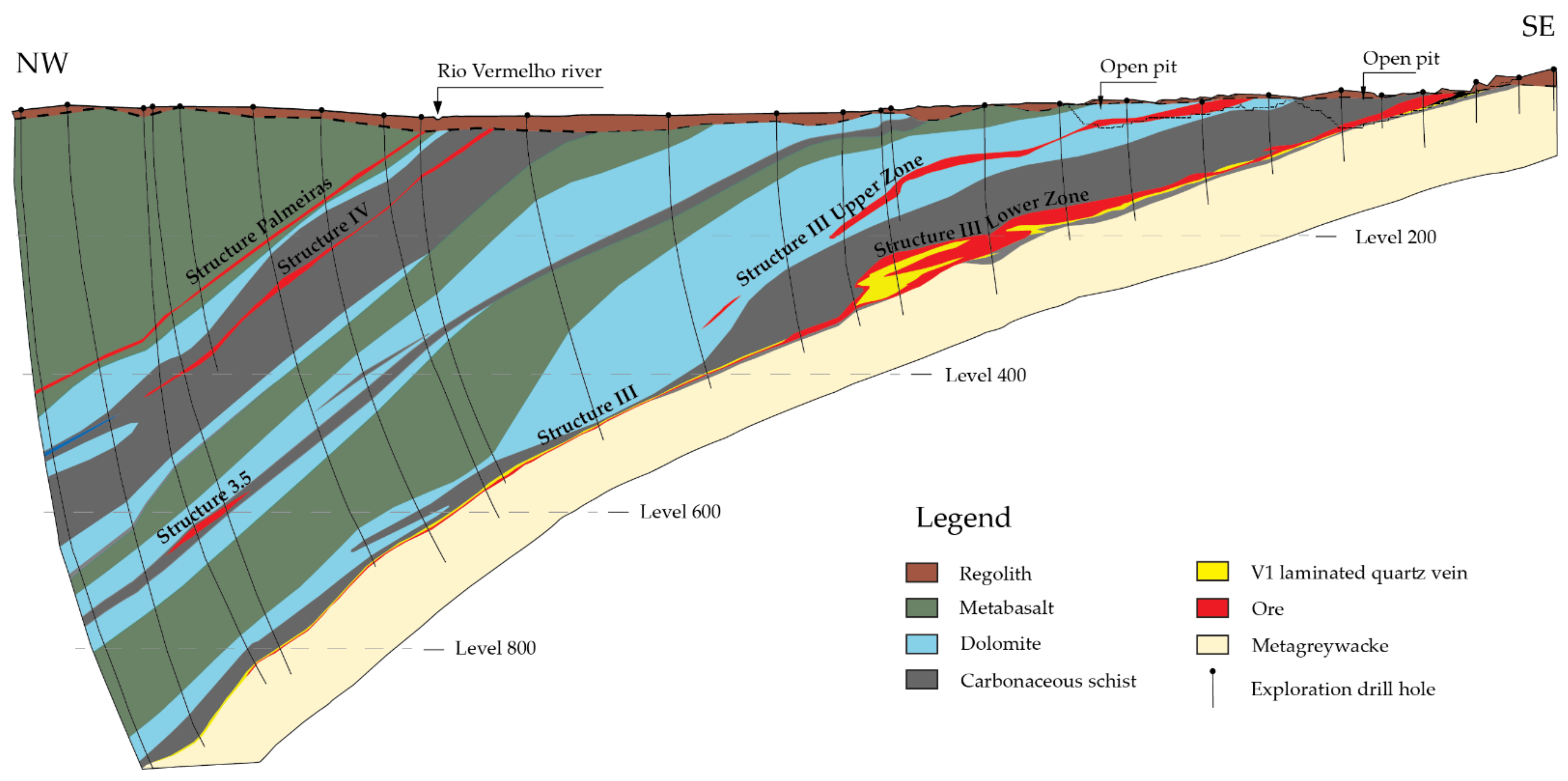
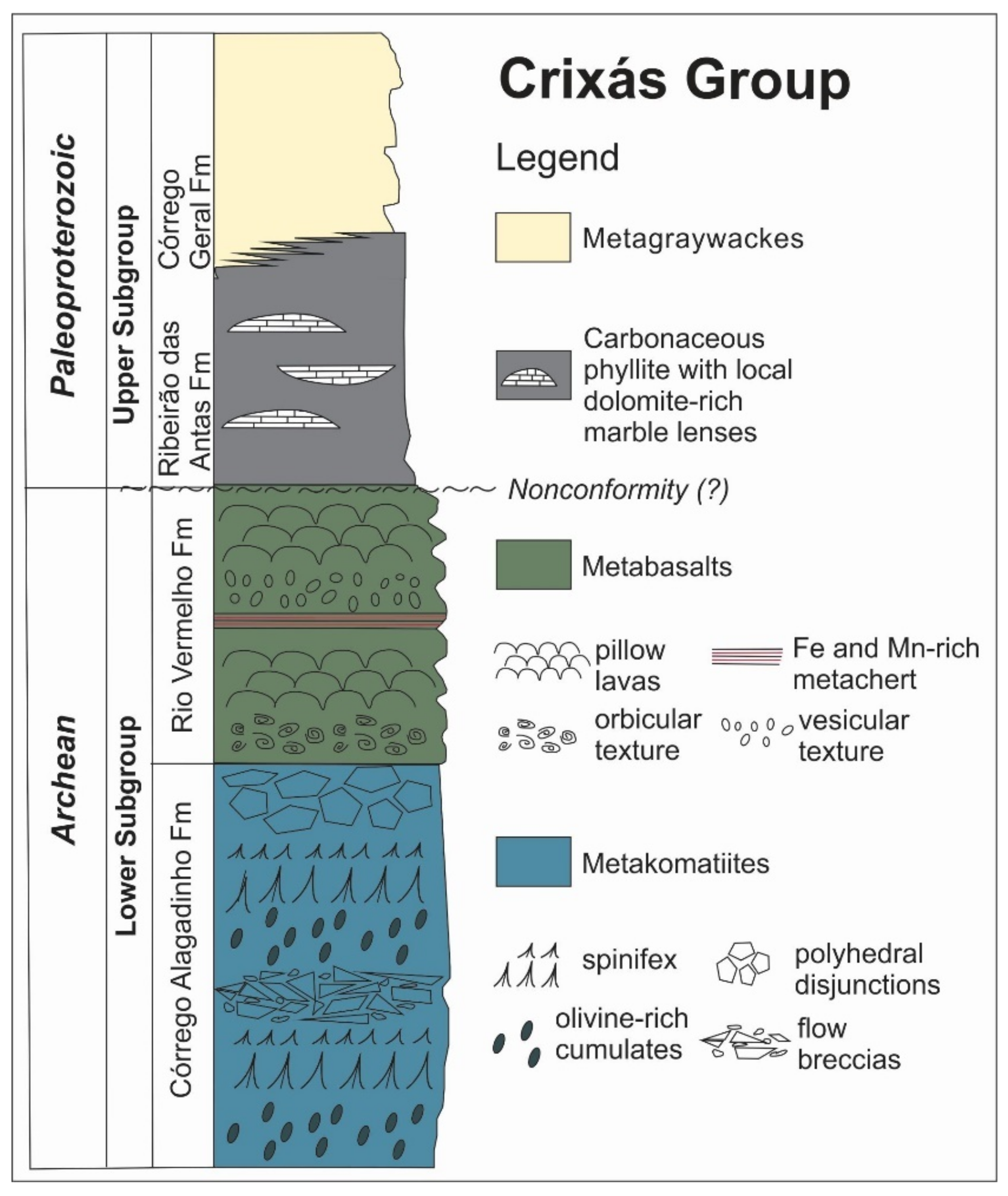

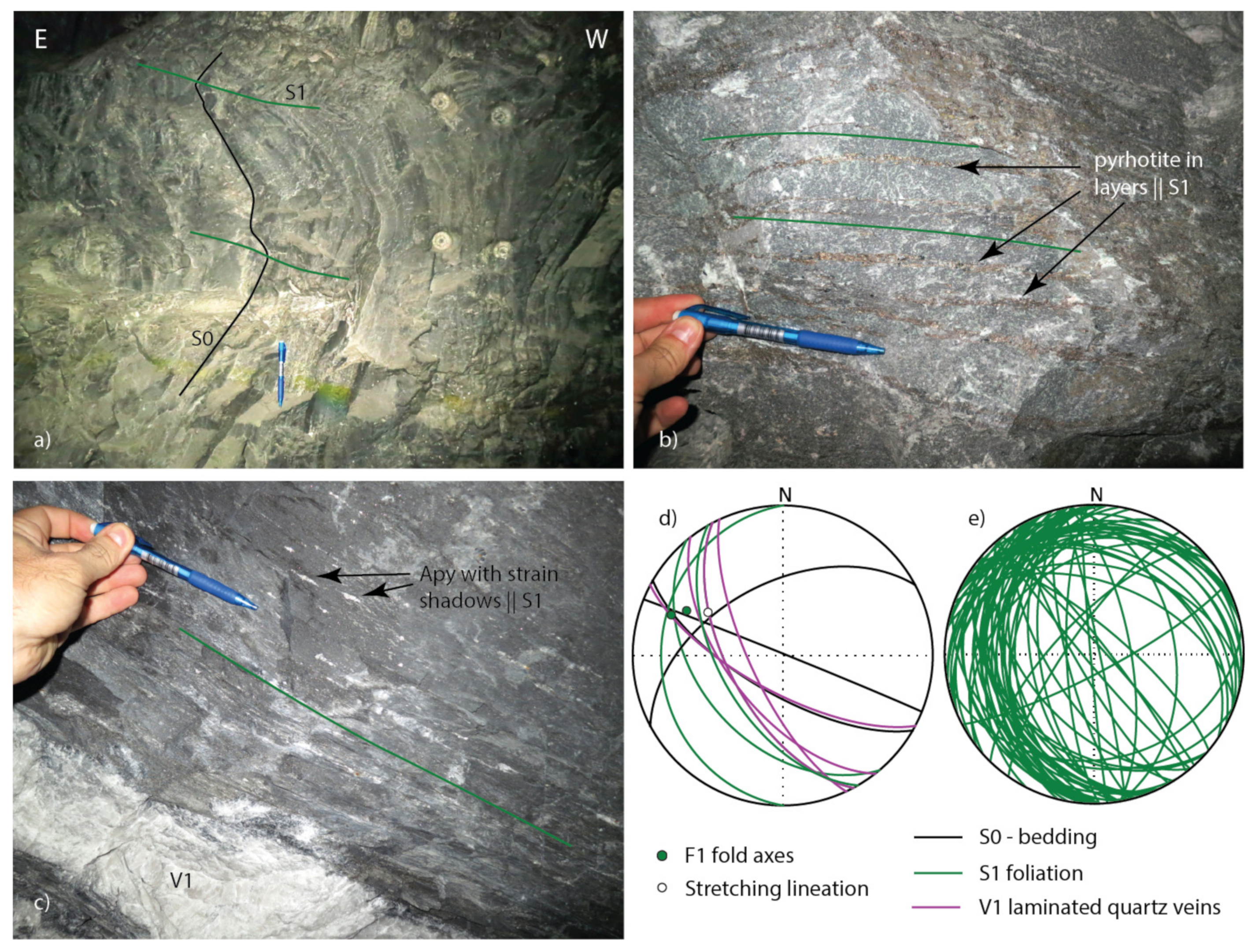

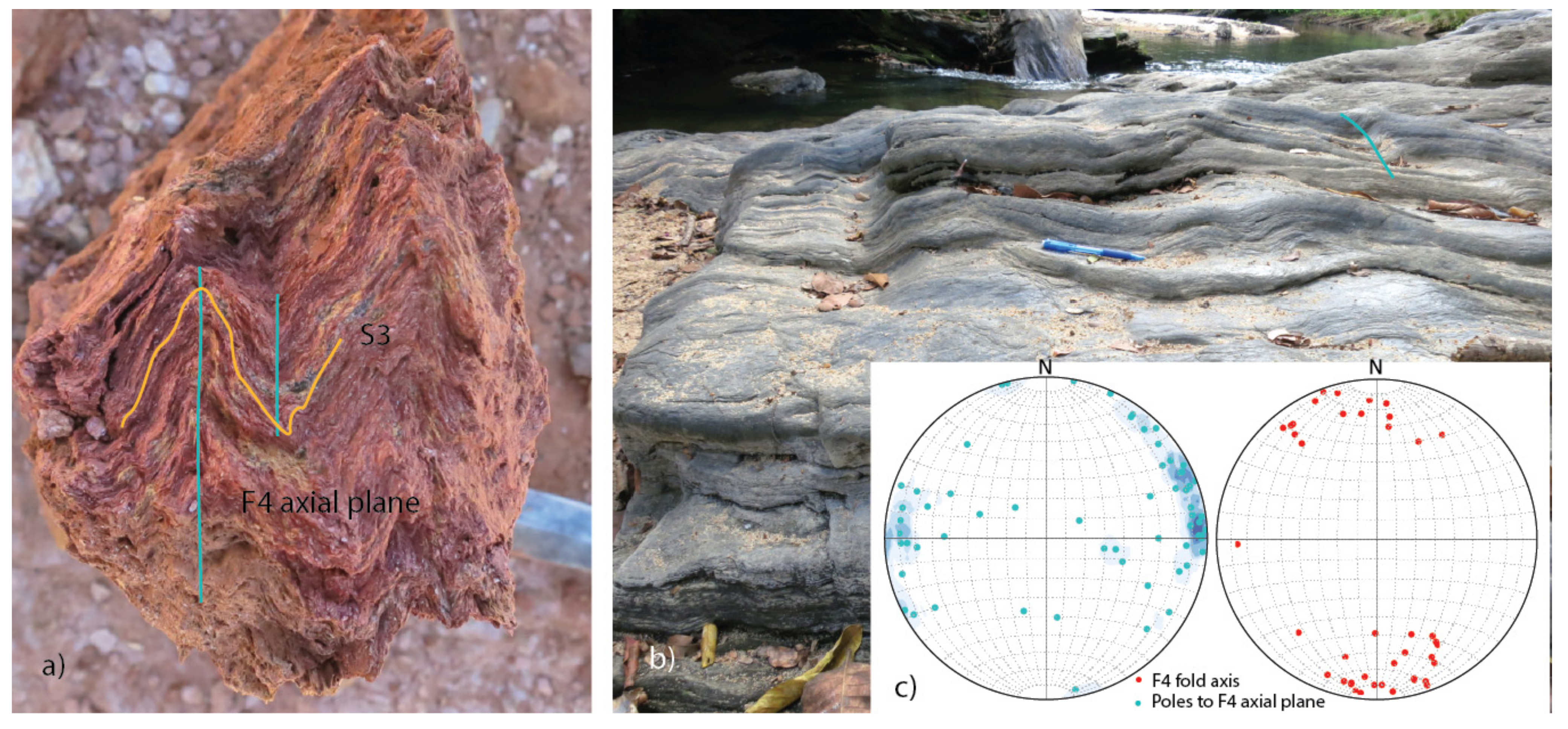
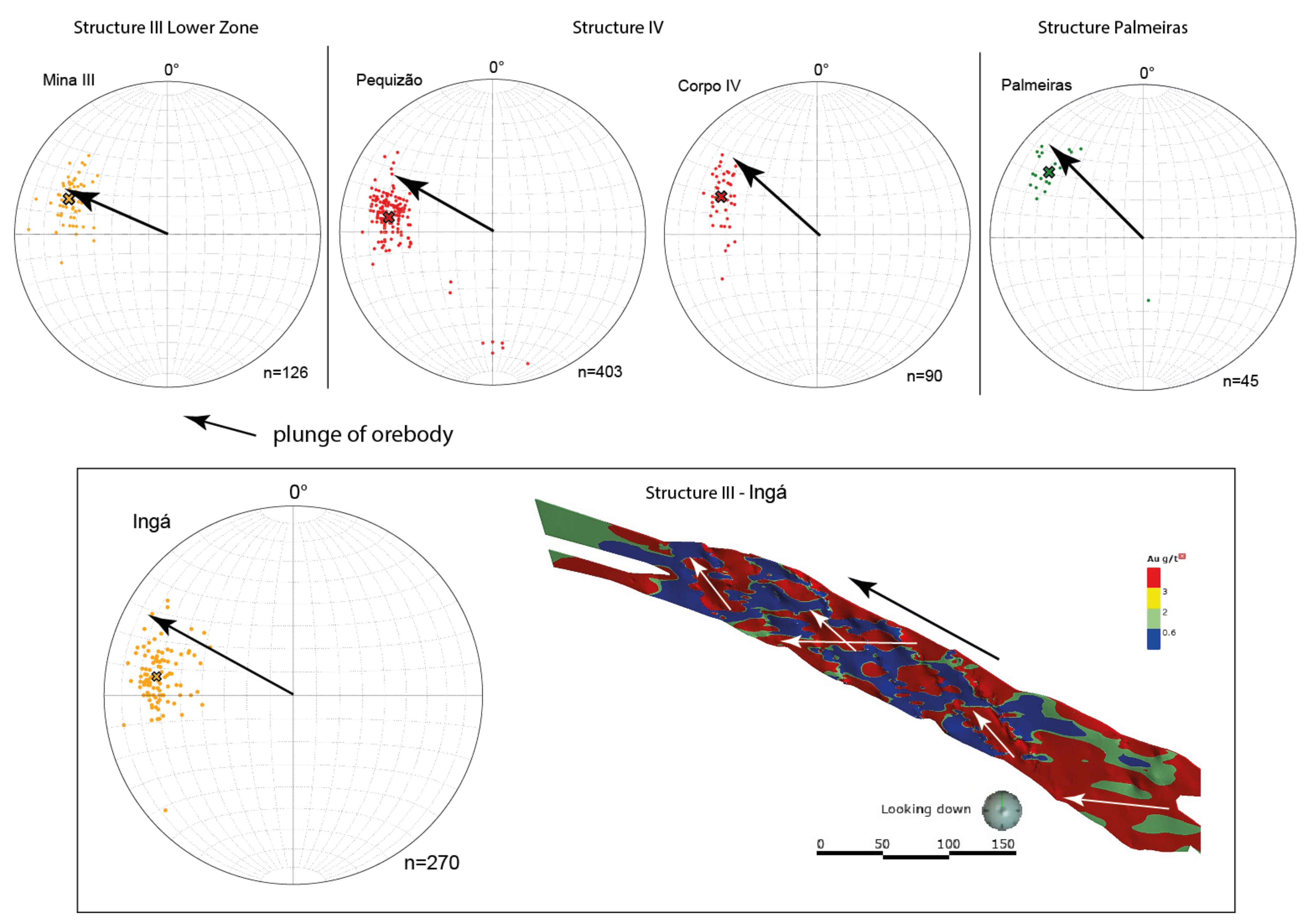
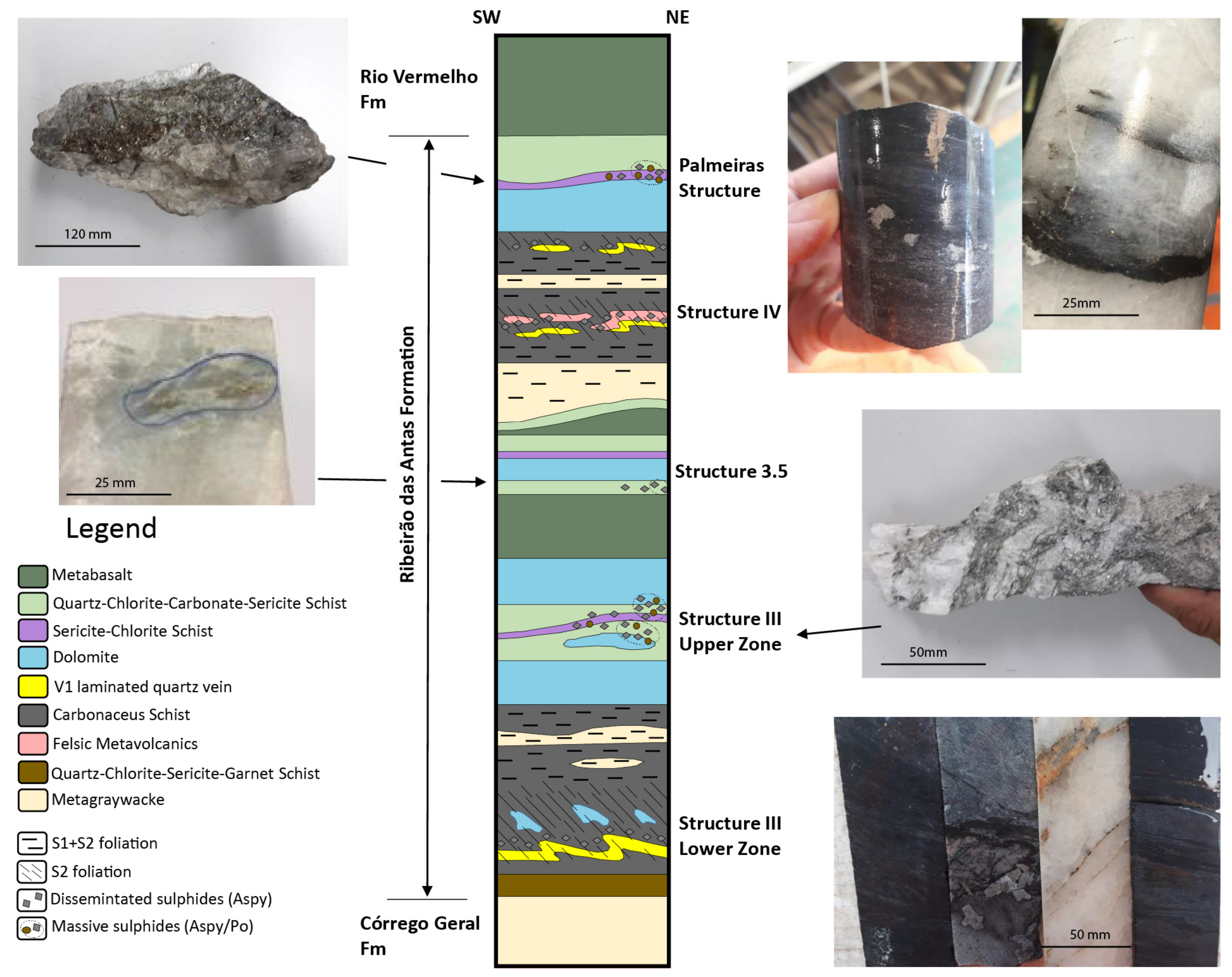

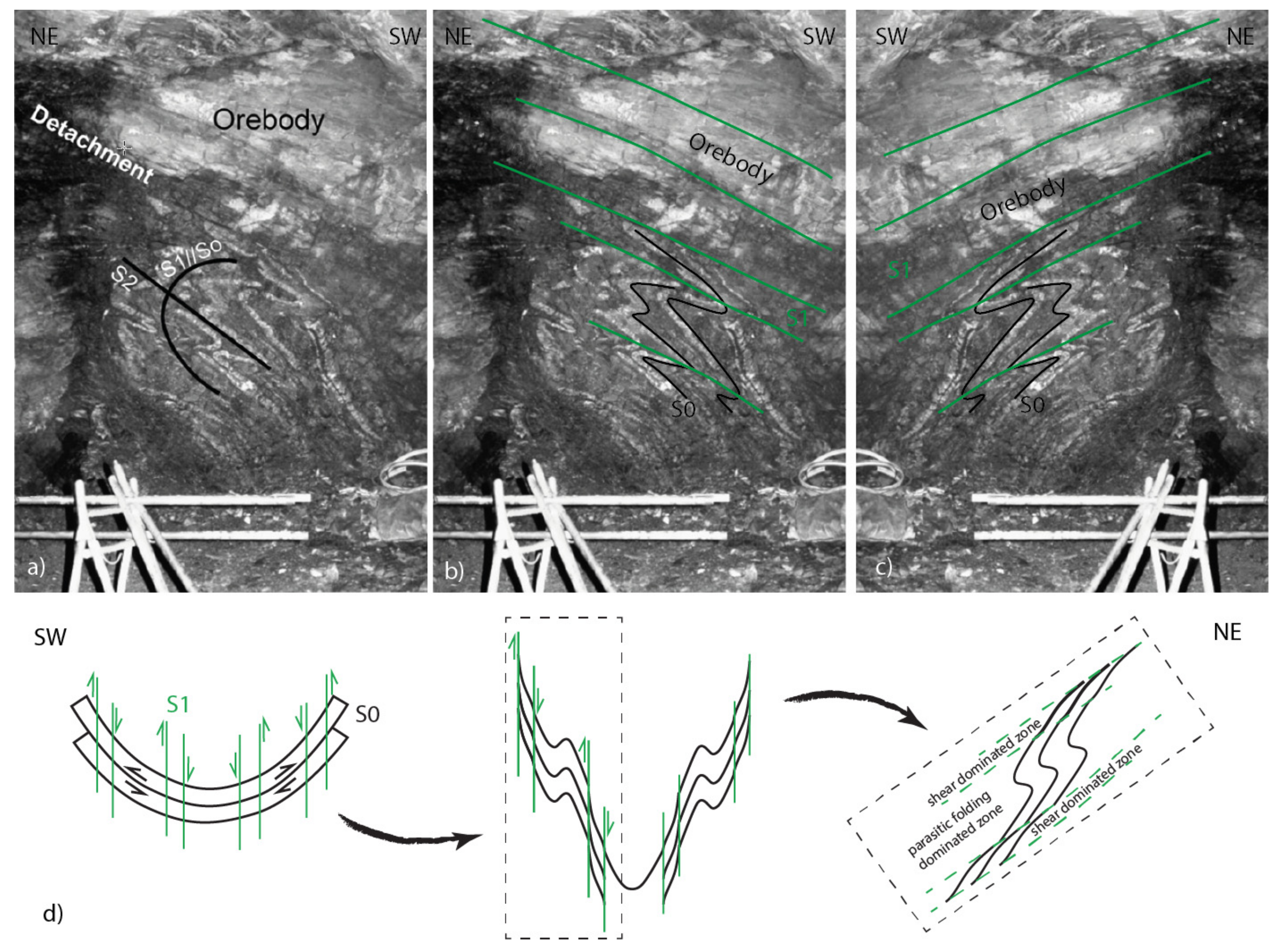

| Unit | Rock | Age (Ma) | Method | Ref. | ||
|---|---|---|---|---|---|---|
| Mafic Dike | 2170 ± 17 | LA-ICP-MS U-Pb (zircon) | [2] | |||
| Crixás Group | Upper subgroup | Córrego Geral Formation | Metagreywacke | 3362 ± 19 to 2209 ± 32 | LA-ICP-MS/SHRIMP U-Pb detrital zircons | [2] |
| Metagreywacke | 2212 ± 36 | SHRIMP U-Pb detrital zircons | [42] | |||
| Metagreywacke | 2165 ± 47 | SHRIMP Hydrothermal zircons (?) | [42] | |||
| Metagreywacke | 2200–2150 ca. 600 (rims) | LA-ICP-MS U-Pb detrital zircons | [4] | |||
| Ribeirão das Antas Formation | Metagreywacke | 2500–2600 and 2200–2150 | LA-ICP-MS U-Pb detrital zircons | [4] | ||
| Carbonaceous phyllite and marble | 2330–2110 (?) | Positive δ13C Anomaly * | [3,37,43] | |||
| Lower subgroup | Rio Vermelho Formation | Metabasalt | 2998 ± 70 ** | Sm-Nd (WR) | [24] | |
| Córrego Alagadinho Formation | Metakomatiite | 2728 ± 140 2825 ± 98 | Pb-Pb (WR) Sm-Nd (WR) | [41] | ||
| Mineralization (Structure III) | Upper Zone | Massive ore | 2126 ± 16 | Re-Os (Apy) | [47] | |
| Lower Zone | Schist | 726–660 518–576 505 ± 10 | Ar-Ar and K-Ar (Hbl, Bt and Cld) Ar-Ar and K-Ar (Ms) | [48] | ||
| Schist | 505 ± 7 | Sm-Nd (grt&WR) | [24] | |||
Publisher’s Note: MDPI stays neutral with regard to jurisdictional claims in published maps and institutional affiliations. |
© 2021 by the authors. Licensee MDPI, Basel, Switzerland. This article is an open access article distributed under the terms and conditions of the Creative Commons Attribution (CC BY) license (https://creativecommons.org/licenses/by/4.0/).
Share and Cite
Ulrich, S.; Hageman, S.; Marques, J.C.; Figueiredo, F.L.A.R.; Ramires, J.E.F.; Frantz, J.C.; Petersen, K. The Orogenic Crixás Gold Deposit, Goiás, Brazil: A Review and New Constraints on the Structural Control of Ore Bodies. Minerals 2021, 11, 1050. https://doi.org/10.3390/min11101050
Ulrich S, Hageman S, Marques JC, Figueiredo FLAR, Ramires JEF, Frantz JC, Petersen K. The Orogenic Crixás Gold Deposit, Goiás, Brazil: A Review and New Constraints on the Structural Control of Ore Bodies. Minerals. 2021; 11(10):1050. https://doi.org/10.3390/min11101050
Chicago/Turabian StyleUlrich, Stanislav, Steffen Hageman, Juliana Charão Marques, Frederico Lana A. R. Figueiredo, João E. F. Ramires, José Carlos Frantz, and Klaus Petersen. 2021. "The Orogenic Crixás Gold Deposit, Goiás, Brazil: A Review and New Constraints on the Structural Control of Ore Bodies" Minerals 11, no. 10: 1050. https://doi.org/10.3390/min11101050
APA StyleUlrich, S., Hageman, S., Marques, J. C., Figueiredo, F. L. A. R., Ramires, J. E. F., Frantz, J. C., & Petersen, K. (2021). The Orogenic Crixás Gold Deposit, Goiás, Brazil: A Review and New Constraints on the Structural Control of Ore Bodies. Minerals, 11(10), 1050. https://doi.org/10.3390/min11101050






